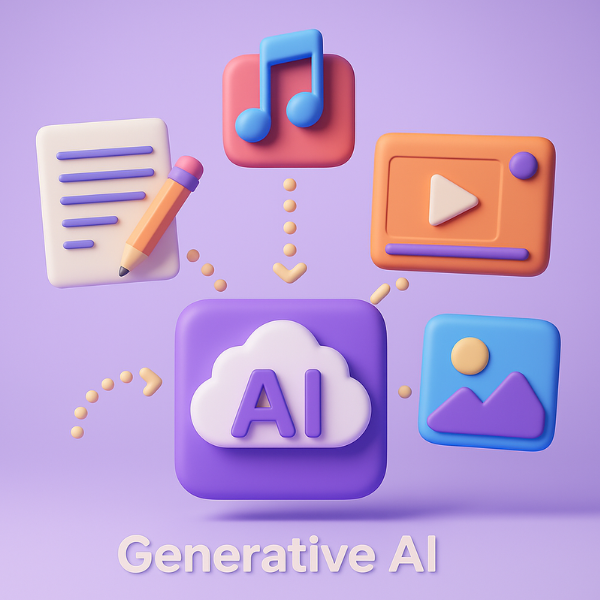Simple AI Term Definitions Every Beginner and Expert Should Know

We are in the age of artificial intelligence. This technology has been growing fast and impacting every domain. Everyone is concerned.
But it’s often seen as confusing or too technical.
In this blog post you’ll find simple definitions of important AI terms that both beginners and experts should know.
It’s an AI glossary with easy definitions, with examples when needed.
The English version of this blog post is organized in alphabetical order, but that’s not necessarily the case for the French version. We update this list from time to time.
If there are words you want us to add, please let us know in the comment section. AIBusinessLift will always do its best to provide you with the best AI education.
Table of Contents
Toggle– Algorithm
An algorithm is a set of instructions that a computer follows to solve a problem or complete a task. It’s a step-by-step guide that tells exactly what to do, in what order, to achieve a desired outcome. AI uses algorithms to process data, learn patterns and perform tasks.
– API (Application Programming Interface)
An API is a set of rules that allows different software or apps to communicate with each other. In AI, it lets you connect AI models to other software or apps.
– Artificial Intelligence (AI)
Artificial Intelligence is the ability of machines or computer program to simulate human intelligence in order to perform tasks.
– AI Automation
AI automation is the use of AI to perform tasks without human intervention. It connects entire processes and streamlines workflows.
Example: ManyChat can automate Instagram DMs, instantly replying to messages, answering questions, or guiding users through sales, all without your presence.
– AI Influencer
An AI influencer, also known as a virtual influencer, is an AI-generated character designed to resemble and interact with audiences on social media platforms like human influencers.
Examples: Shudu Gram, Lil Miquela, Imma, Noonoouri
– Bias
AI Bias is when an AI system makes unfair or inaccurate decisions because the data it was trained on has hidden preferences, stereotypes, or imbalances.
Example: If a hiring AI is trained mostly on resumes from men, it might unfairly favor men candidates over women.
– Chatbots
Chatbots are AI tools that talk to users by simulating the way humans interact. They are often used for answering questions, doing customer service or having various types of conversations online.
– Cloud
The Cloud refers to a network of remote servers that store, manage, and process data over the internet, rather than relying on a local computer or server.
Example: Amazon Web Services (AWS), Google Cloud, Microsoft Azure
– Computer Vision
Computer vision is a field of AI that helps machines see and understand images or videos, allowing them to make decisions based on visual data.
Example: Self-driving cars use computer vision to “see” the road, detect obstacles, and make decisions like stopping for traffic lights.
– Data Mining
Data Mining is the process of analyzing large datasets to uncover patterns, correlations, or trends that can be used to improve a model.
– Dataset
Dataset is a collection of data (text, images, audio, etc.) used to train or test an AI model.
– Deep Learning
Deep Learning is a type of machine learning that uses neural networks to analyze large amounts of data and make decisions.
Example: Detecting faces in surveillance videos or recommending ads based on online activity.
– Deepfake

Deepfake is a technology that uses generative AI (image, video, audio) to create very realistic content that looks real. It can be used in positive ways, but most of the time it’s used to manipulate or deceive people.
Example: An AI video or image that shows a real person (like a famous person) speaking or doing something and it looks real.
– Ethics in AI
AI Ethics is the set of moral principles that govern the development and use of AI to ensure fairness, transparency, security, and respect for people’s rights, while avoiding harm or misuse.
– Fine-tuning
Fine-tuning is the process of taking a pre-trained AI model and training it a bit more on your own dataset to make it better at your specific task.
– General AI
General Artificial Intelligence (AGI) also called Strong AI is an artificial intelligence that can understand, learn, solve problems in any area, adapt and perform any intellectual task a human can do.
It doesn’t exist yet, but it’s the goal of many AI researchers.
– Generative AI

Generative AI is a type of artificial intelligence that focuses on creating new content like text, images, music, video, or code, by learning patterns from the data it’s trained on.
Example: ChatGPT, Midjourney, Gemini, Copilot.
– Generative Pre-trained Transformer (GPT)
A GPT is an AI model trained on large amounts of text to understand and generate human-like language.
It’s a type of generative AI specifically designed for text-based tasks (chatting, summarizing, translating, coding, etc.). All GPT models belong to OpenAI.
Examples: GPT-3.5, GPT-4, GPT-4o.
– Hallucination
Hallucination in AI is when an AI generates information that isn’t true or doesn’t exist, like making up facts or details that weren’t part of the training data.
– Humanizing AI
Humanizing AI is the process of making AI systems or AI-generated content feel more natural and human-like by adding qualities such as empathy, emotions, a conversational tone and removing robotic patterns.
If you’d like to become an expert in humanizing text, check out the blog post 18 Ways to Humanize AI Content.
– Large Language Model (LLM)
LLMs are AI models that learn from huge amounts of text. They can understand and create text, helping with tasks like writing, translating, or chatting.
Example: GPT-4, GPT-4o , Claude 3, LLaMA, BERT, Gemini 1
– Model
A model is an AI program that has learned from data and performs tasks.
Examples: DALL·E, GPT-4, GPT-4o, Claude 3, LLaMA, BERT, Gemini 1
In a different context, an AI model refers to a virtual character or digital persona created using artificial intelligence.
It’s often used in fashion, advertising, illustration or social media. Some of them are AI influencers, while others are not because they don’t have a social media presence.
Examples (AI model influencers): Shudu Gram, Noonoouri, Imma
– Multimodal Models
Multimodal models (also known as multimodal AI) are AIs that can understand and process at least two types of input, such as text, images, audio or video.
It’s about the number of prompt formats they can handle (text, images, audio or video).
To be considered multimodal, an AI tool must accept at least two different types of input.
If an AI tool only accepts one input type it’s called a unimodal system.
Example : AI tools like Quillbot and wordtune where you can only add text and nothing else are unimodal. But in ChatGPT you can add text, images and audio, so it is multimodal.
– Narrow AI
Narrow AI also called Weak AI is an artificial intelligence designed to do one specific task very well.
Examples: Siri, Google Translate, ElevenLabs, ChatGpt
– Natural Language Processing (NLP)
NLP is the ability of AI to understand, interpret, and generate human language in order to interact with text or speech.
Example: Virtual assistants like Siri or Alexa use NLP
– Neural Network
A neural network is a system of algorithms inspired by the human brain. It is made up of layers of “neurons” and is used in many AI models, especially in deep learning.
– Overfitting
Overfitting is when an AI model learns the details of its training data too well and focuses too closely or exactly on it, to the point that it performs poorly on new, unseen data.
– Prompt
A prompt is the instruction (input) you give to an AI tool to generate a response (output). It tells it what to do.
– Prompt Ingineering
Prompt engineering is the skill of crafting the best possible prompt to get the most desired result from an AI tool.
– Reinforcement Learning (RL)
Reinforcement learning is a type of machine learning that teaches AI to make decisions by interacting with an environment and receiving feedback in the form of rewards or punishments. The AI learns by trial and error.
A more advanced form of RL is deep reinforcement learning, which combines reinforcement learning and deep learning to handle more complex tasks.
Example: AlphaZero by DeepMind demonstrated the ability to learn chess (and other games like Go and Shogi) from scratch, without prior human knowledge or data, simply by playing against itself.
– Scraping

Scraping is the process where AI or software automatically collects data from websites. It’s used to gather information like text, images, or other resources quickly.
Example: AI gathering information from the internet to train a model or give real-time answers.
– Supervised Learning (SL)
Supervised learning is a type of machine learning where AI is trained with labeled data to predict outcomes or recognize patterns. The correct answers are provided in the data, so the AI learns from examples.
Example: Teaching AI with flashcards: “This is a cat. This is a dog.”
– Unsupervised Learning
Unsupervised learning is a type of machine learning where AI is trained with unlabeled data, without knowing the correct answers, to discover hidden patterns and relationships. It figures things out on its own.
Example: Grouping similar items together, like Amazon’s recommendation system does.
Conclusion
AI is changing the way we live and work. Knowing the main terms and ideas helps us understand this fast-growing technology.
It’s important to keep up with AI to stay ahead of both the opportunities and the threats.
We’ll keep updating this glossary as AI keeps developing. If there are any words you want us to add, just let us know in the comments!



